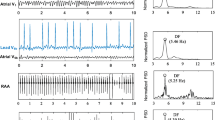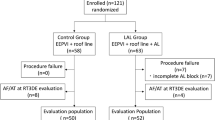Abstract
Background
The left atrial appendage (LAA) is a possible key contributor to the maintenance of persistent atrial fibrillation (PsAF). The effect of LAA ostial ablation on global left atrial higher-frequency sources remains unclear.
Methods
Complex fractionated electrograms (CFEs) and dominant frequency (DF) maps acquired with a NavX system in 58 PsAF patients were enrolled and examined before and after LAA posterior ridge ablation, which followed a stepwise linear ablation.
Results
High-density left atrial mapping identified continuous CFE sites in 50 % and high-DFs (≥8 Hz) in 53 % of patients at the LAA posterior ridge. In 44 patients in whom AF persisted despite pulmonary vein isolation (PVI) and linear ablation, LAA ablation significantly increased the mean CFE cycle length from 98 ± 29 to 108 ± 30 ms (P < 0.0001) and decreased DF from 6.1 ± 0.8 to 5.9 ± 0.8 Hz (P < 0.005) within the coronary sinus (CS). A multivariate analysis showed single-procedure failures could be predicted by the left atrial volume index and absence of continuous CFEs at the LAA posterior ridge region. The percent decrease in the global left atrial DF after LAA posterior ridge ablation was significantly lower in the patients with than in those without an enlarged left atrium (LA) (>90 mL/m2) (median 0 vs 4.8 %; P < 0.01) and significantly lower in the patients with than in those without the absence of continuous CFEs in the LAA posterior ridge region (median 0.6 vs 4.8 %; P < 0.05).
Conclusion
These findings suggested that an approach incorporating an LAA posterior ridge ablation was effective in modifying higher-frequency sources in the global LA in PsAF patients, but a lesser effect was documented in patients with electroanatomical remodeling of the LA.





Similar content being viewed by others
References
Calkins, H., Brugada, J., Packer, D. L., Cappato, R., Chen, S. A., Crijns, H. J., et al. (2007). HRS/EHRA/ECAS expert consensus statement on catheter and surgical ablation of atrial fibrillation: recommendations for personnel, policy, procedures and follow-up. A report of the Heart Rhythm Society (HRS) Task Force on catheter and surgical ablation of atrial fibrillation. [Consensus Development Conference Practice Guideline Review]. Heart Rhythm, 4(6), 816–861.
Haissaguerre, M., Jais, P., Shah, D. C., Takahashi, A., Hocini, M., Quiniou, G., et al. (1998). Spontaneous initiation of atrial fibrillation by ectopic beats originating in the pulmonary veins. The New England Journal of Medicine, 339(10), 659–666.
Nademanee, K., McKenzie, J., Kosar, E., Schwab, M., Sunsaneewitayakul, B., Vasavakul, T., et al. (2004). A new approach for catheter ablation of atrial fibrillation: mapping of the electrophysiologic substrate. [Evaluation Studies]. Journal of the American College of Cardiology, 43(11), 2044–2053.
Verma, A., Lakkireddy, D., Wulffhart, Z., Pillarisetti, J., Farina, D., Beardsall, M., et al. (2011). Relationship between complex fractionated electrograms (CFE) and dominant frequency (DF) sites and prospective assessment of adding DF-guided ablation to pulmonary vein isolation in persistent atrial fibrillation (AF). Journal of Cardiovascular Electrophysiology, 22(12), 1309–1316.
Di Biase, L., Burkhardt, J. D., Mohanty, P., Sanchez, J., Mohanty, S., Horton, R., et al. (2010). Left atrial appendage: an underrecognized trigger site of atrial fibrillation. [Clinical Trial Comparative Study Multicenter Study]. Circulation, 122(2), 109–118.
Yoshida, K., Ulfarsson, M., Oral, H., Crawford, T., Good, E., Jongnarangsin, K., et al. (2011). Left atrial pressure and dominant frequency of atrial fibrillation in humans. [Comparative Study Research Support, Non-U.S. Gov’t]. Heart Rhythm, 8(2), 181–187.
Hocini, M., Shah, A. J., Nault, I., Sanders, P., Wright, M., Narayan, S. M., et al. (2011). Localized reentry within the left atrial appendage: arrhythmogenic role in patients undergoing ablation of persistent atrial fibrillation. Heart Rhythm, 8(12), 1853–1861.
Nakahara, S., Toratani, N., Nakamura, H., Higashi, A., & Takayanagi, K. (2012). Spatial relationship between high-dominant-frequency sites and the linear ablation line in persistent atrial fibrillation: its impact on complex fractionated electrograms. Europace.
Koruth, J. S., Heist, E. K., Danik, S., Barrett, C. D., Kabra, R., Blendea, D., et al. (2011). Accuracy of left atrial anatomical maps acquired with a multielectrode catheter during catheter ablation for atrial fibrillation. [Research Support, Non-U.S. Gov’t]. Journal of Interventional Cardiac Electrophysiology, 32(1), 45–51.
Haissaguerre, M., Hocini, M., Takahashi, Y., O’Neill, M. D., Pernat, A., Sanders, P., et al. (2007). Impact of catheter ablation of the coronary sinus on paroxysmal or persistent atrial fibrillation. [Clinical Trial Comparative Study Research Support, Non-U.S. Gov’t]. Journal of Cardiovascular Electrophysiology, 18(4), 378–386.
Lin, Y. J., Tai, C. T., Kao, T., Chang, S. L., Lo, L. W., Tuan, T. C., et al. (2009). Spatiotemporal organization of the left atrial substrate after circumferential pulmonary vein isolation of atrial fibrillation. [Clinical Trial Research Support, Non-U.S. Gov’t]. Circulation. Arrhythmia and Electrophysiology, 2(3), 233–241.
Nademanee, K., Schwab, M., Porath, J., & Abbo, A. (2006). How to perform electrogram-guided atrial fibrillation ablation. [Review]. Heart Rhythm, 3(8), 981–984.
Lin, Y. J., Tsao, H. M., Chang, S. L., Lo, L. W., Hu, Y. F., Chang, C. J., et al. (2010). Role of high dominant frequency sites in nonparoxysmal atrial fibrillation patients: insights from high-density frequency and fractionation mapping. [Comparative Study Research Support, Non-U.S. Gov’t]. Heart Rhythm, 7(9), 1255–1262.
Lin, Y. J., Tai, C. T., Kao, T., Tso, H. W., Higa, S., Tsao, H. M., et al. (2006). Frequency analysis in different types of paroxysmal atrial fibrillation. Journal of the American College of Cardiology, 47(7), 1401–1407.
Moore, K. L. (1998). The developing human: Clinically oriented embryology (6th ed.). Philadelphia: Saunders Co.
Yoshida, K., Chugh, A., Good, E., Crawford, T., Myles, J., Veerareddy, S., et al. (2010). A critical decrease in dominant frequency and clinical outcome after catheter ablation of persistent atrial fibrillation. [Research Support, Non-U.S. Gov’t]. Heart Rhythm, 7(3), 295–302.
Kumar, S., Morton, J. B., Lee, J., Halloran, K., Spence, S. J., Gorelik, A., et al. (2012). Prospective characterization of catheter-tissue contact force at different anatomic sites during antral pulmonary vein isolation. [Comparative Study Research Support, Non-U.S. Gov’t]. Circulation. Arrhythmia and Electrophysiology, 5(6), 1124–1129.
Haissaguerre, M., Hocini, M., Sanders, P., Takahashi, Y., Rotter, M., Sacher, F., et al. (2006). Localized sources maintaining atrial fibrillation organized by prior ablation. [Research Support, Non-U.S. Gov’t]. Circulation, 113(5), 616–625.
Haissaguerre, M., Sanders, P., Hocini, M., Takahashi, Y., Rotter, M., Sacher, F., et al. (2005). Catheter ablation of long-lasting persistent atrial fibrillation: critical structures for termination. [Research Support, Non-U.S. Gov’t]. Journal of Cardiovascular Electrophysiology, 16(11), 1125–1137.
Cabrera, J. A., Ho, S. Y., Climent, V., & Sanchez-Quintana, D. (2008). The architecture of the left lateral atrial wall: a particular anatomic region with implications for ablation of atrial fibrillation. [Research Support, Non-U.S. Gov’t]. European Heart Journal, 29(3), 356–362.
Berenfeld, O., Zaitsev, A. V., Mironov, S. F., Pertsov, A. M., & Jalife, J. (2002). Frequency-dependent breakdown of wave propagation into fibrillatory conduction across the pectinate muscle network in the isolated sheep right atrium. [In Vitro Research Support, Non-U.S. Gov’t Research Support, U.S. Gov’t, P.H.S.]. Circulation Research, 90(11), 1173–1180.
Hoit, B. D., & Walsh, R. A. (1992). Regional atrial distensibility. [Research Support, Non-U.S. Gov’t Research Support, U.S. Gov’t, P.H.S.]. The American Journal of Physiology, 262(5 Pt 2), H1356–H1360.
Tabata, T., Oki, T., Yamada, H., Iuchi, A., Ito, S., Hori, T., et al. (1998). Role of left atrial appendage in left atrial reservoir function as evaluated by left atrial appendage clamping during cardiac surgery. The American Journal of Cardiology, 81(3), 327–332.
Grubitzsch, H., Grabow, C., Orawa, H., & Konertz, W. (2008). Factors predicting the time until atrial fibrillation recurrence after concomitant left atrial ablation. European Journal of Cardio-Thoracic Surgery, 34(1), 67–72.
Matsuo, S., Lim, K. T., & Haissaguerre, M. (2007). Ablation of chronic atrial fibrillation. Heart Rhythm: the Official Journal of the Heart Rhythm Society, 4(11), 1461–1463.
Jadidi, A. S., Duncan, E., Miyazaki, S., Lellouche, N., Shah, A. J., Forclaz, A., et al. (2012). Functional nature of electrogram fractionation demonstrated by left atrial high-density mapping. [Comparative Study Research Support, Non-U.S. Gov’t]. Circulation. Arrhythmia and Electrophysiology, 5(1), 32–42.
Stiles, M. K., Brooks, A. G., Kuklik, P., John, B., Dimitri, H., Lau, D. H., et al. (2008). High-density mapping of atrial fibrillation in humans: relationship between high-frequency activation and electrogram fractionation. [Research Support, Non-U.S. Gov’t]. Journal of Cardiovascular Electrophysiology, 19(12), 1245–1253.
Wu, J., Estner, H., Luik, A., Ucer, E., Reents, T., Pflaumer, A., et al. (2008). Automatic 3D mapping of complex fractionated atrial electrograms (CFAE) in patients with paroxysmal and persistent atrial fibrillation. Journal of Cardiovascular Electrophysiology, 19(9), 897–903.
Conflict of interest
None.
Financial support
None.
Disclosures
None.
Author information
Authors and Affiliations
Corresponding author
Rights and permissions
About this article
Cite this article
Nakahara, S., Hori, Y., Hayashi, A. et al. Impact of left atrial appendage ridge ablation on the complex fractionated electrograms in persistent atrial fibrillation. J Interv Card Electrophysiol 41, 55–64 (2014). https://doi.org/10.1007/s10840-014-9902-2
Received:
Accepted:
Published:
Issue Date:
DOI: https://doi.org/10.1007/s10840-014-9902-2




